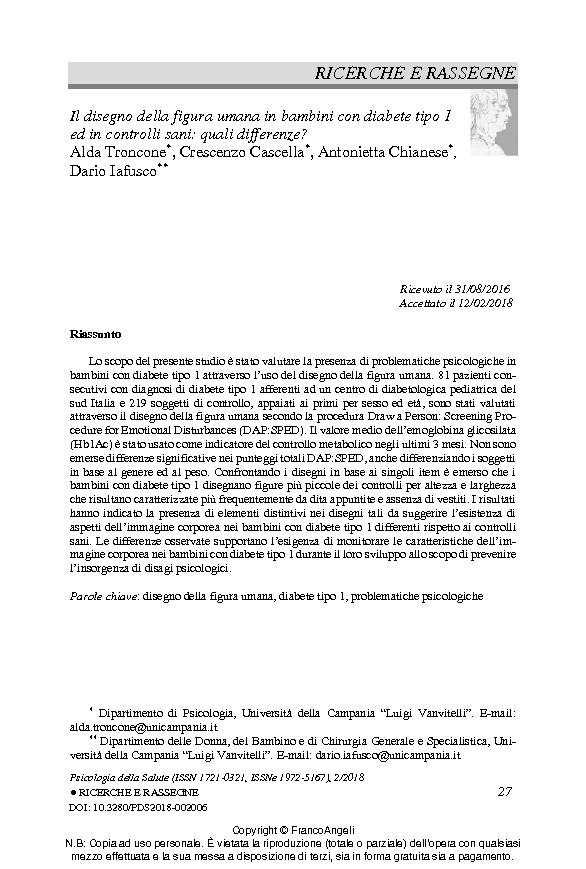Il disegno della figura umana in bambini con diabete tipo 1 ed in controlli sani : quali differenze?
27-44 p.
Lo scopo del presente studio è stato valutare la presenza di problematiche psicologiche in bambini con diabete tipo 1 attraverso l'uso del disegno della figura umana. 81 pazienti consecutivi con diagnosi di diabete tipo 1 afferenti ad un centro di diabetologica pediatrica del sud Italia e 219 soggetti di controllo, appaiati ai primi per sesso ed età, sono stati valutati attraverso il disegno della figura umana secondo la procedura Draw a Person: Screening Procedure for Emotional Disturbances (DAP:SPED). Il valore medio dell'emoglobina glicosilata (Hb1Ac) è stato usato come indicatore del controllo metabolico negli ultimi 3 mesi. Non sono emerse differenze significative nei punteggi totali DAP:SPED, anche differenziando i soggetti in base al genere ed al peso. Confrontando i disegni in base ai singoli item è emerso che i bambini con diabete tipo 1 disegnano figure più piccole dei controlli per altezza e larghezza che risultano caratterizzate più frequentemente da dita appuntite e assenza di vestiti.
I risultati hanno indicato la presenza di elementi distintivi nei disegni tali da suggerire l'esistenza di aspetti dell'immagine corporea nei bambini con diabete tipo 1 differenti rispetto ai controlli sani. Le differenze osservate supportano l'esigenza di monitorare le caratteristiche dell'immagine corporea nei bambini con diabete tipo 1 durante il loro sviluppo allo scopo di prevenire l'insorgenza di disagi psicologici. [Testo dell'editore].
The purpose of this study was to evaluate the presence of psychological problems in children with type 1 diabetes by using human figure drawings. A total of 81 consecutive patients attending an Southern Italian university pediatric diabetology centre with a diagnosis of type 1 diabetes, along with 219 control subjects matched to the study group for age and gender, were asked to draw human figure drawings according to the Draw a Person: Screening Procedure for Emotional Disturbances (DAP:SPED). The glycosylated hemoglobin (HbA1C) mean value, measured every 3 months over the past year, was used as a measure of metabolic control. No significant differences between the children with type 1 diabetes and controls in the DAP:SPED total scores were observed, even when they were differentiated by gender or by weight An item by item human figure drawings comparison showed that the children with type 1 diabetes drew smaller figures for height and width than the controls,
with more frequent presence of pointed fingers and the absence of clothes. Findings indicated the presence of distinctive elements in human figure drawings suggesting the existence of aspects of body image which characterize children with type 1 diabetes and distinguish them from healthy children. The differences observed support the need for monitoring the characteristics of body image in children with type 1 diabetes during the course of the development in order to increase the efficacy of early action to prevent the onset of psychological problems. [Publishers' text].
-
Articles from the same issue (available individually)
-
Information
ISSN: 1972-5167
KEYWORDS
- Disegno della figura umana, diabete tipo 1, problematiche psicologiche
- Human figure drawing, type 1 diabetes, psychological problems



